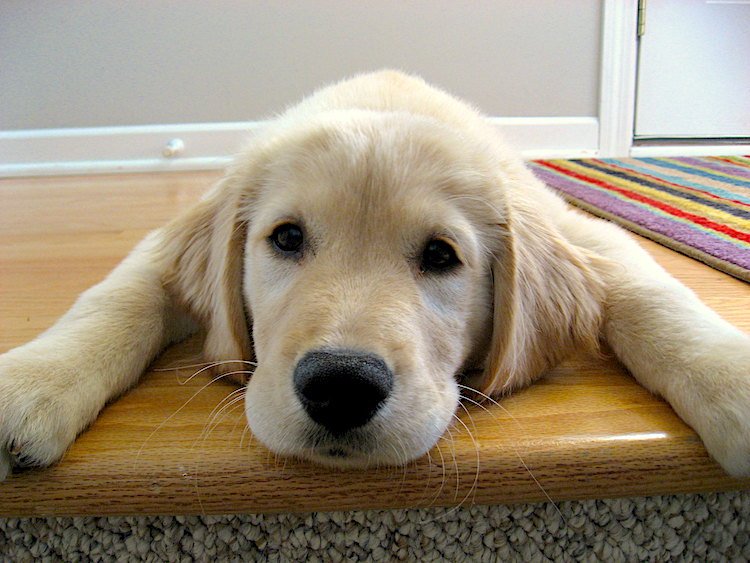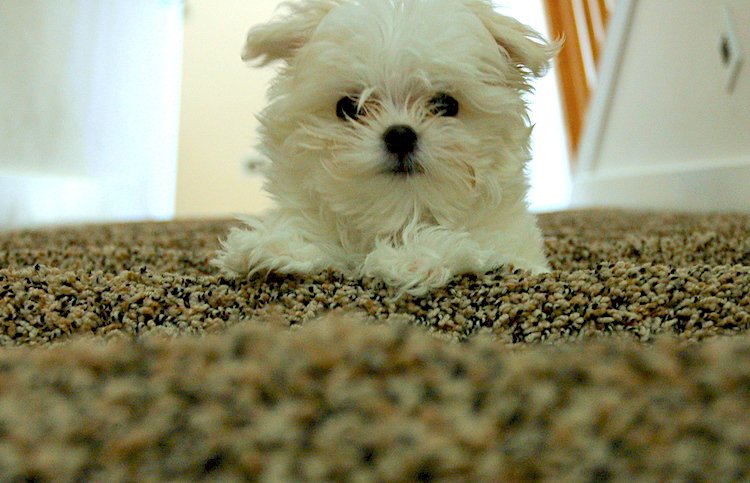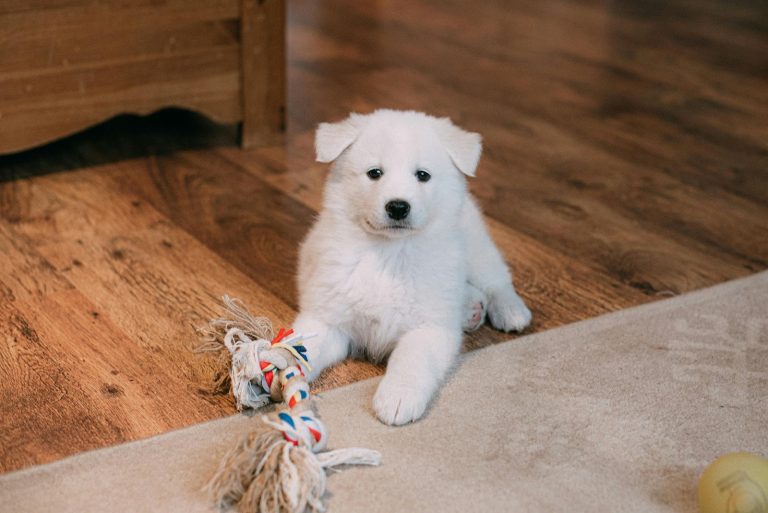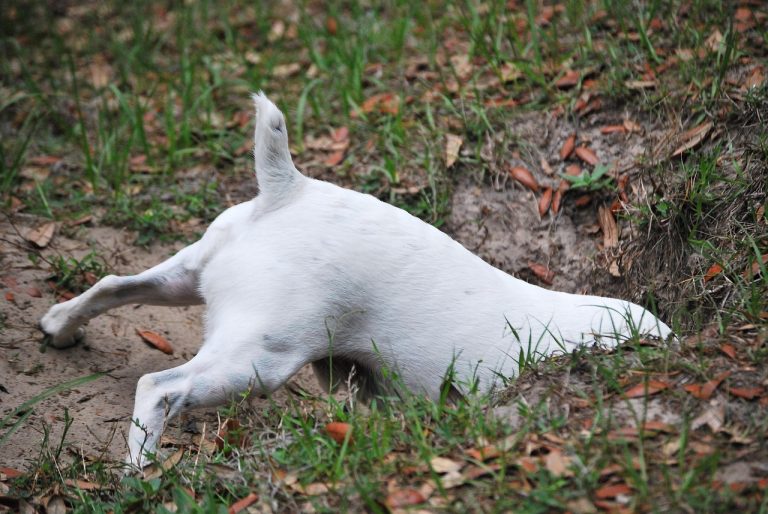How to Teach Your Puppy to Climb the Stairs
Stairs can be tricky for puppies. Here’s how to teach your puppy to climb the stairs — plus, how to troubleshoot when the training isn’t working.

One of the cutest things about a puppy is how clumsy and gangly they are while young.
Puppies are small, their coordination isn’t fully developed, their paws and legs can be too big for their bodies, they lack experience — and, yes, they are just plain clumsy.
Now add a long staircase to the mix, and is it any wonder your puppy feels nervous around stairs? Imagine being your puppy’s size and navigating stairs for the first time.
In this expert guide from Petful, we’ll cover:
- How to teach your puppy to climb the stairs
- How to troubleshoot when the training isn’t working
- What to do when your puppy can’t go up the stairs on their own


Don’t leave your pet’s safety to chance
Sign up for Petful recall alerts today.

How to Teach Your Puppy to Climb the Stairs
Two of the most important things you need for teaching your puppy to climb stairs: patience and a confident attitude.
Your pup will be looking to you and your responses to decide whether they think something is safe or not. If you project fear, feeling sorry for the puppy or nervousness, your puppy will typically feel worried as well.
Sympathize with the dog’s challenge so you can be patient. But keep a confident attitude: They can do this, and you’re going to show them how.
Here are some step-by-step training instructions:
- Take your puppy to the bottom of a small, non-slippery staircase. Examples include a couple of steps leading outside, a carpeted staircase with a landing, or any other staircase that’s not slippery and not a full flight of stairs. You may need to visit a friend with a carpeted staircase for this initial training.
- Place some kibble or a few small treats on the bottom 2–3 steps. Start this training at the bottom because most dogs find it easier to go up the stairs than down the stairs.
- As the puppy begins to get comfortable walking up the first few steps, gradually place more treats on higher steps, one at a time.
- Finally, place treats on all the steps, allowing your puppy to practice going up and down the stairs at their own pace to earn their treats.
- When they reach the top of the stairs, praise them enthusiastically to boost their confidence. Stay quiet while they are navigating the stairs so as to avoid distracting them.
- If the puppy slips and falls at any point, praise them and give a few treats, one at a time. This type of confident response may prevent them from becoming afraid of the stairs in the future.
- Once your puppy is confidently navigating the stairs up and down, remove the rewards.

How to Troubleshoot When the Training Isn’t Working
Most puppies are curious enough and food-motivated enough that treat incentives and patience will help them overcome their reluctance to climb stairs. However, occasionally a puppy won’t be motivated enough or will be too timid to climb the stairs.
When that’s the case, consider trying one of the following suggestions to help the puppy overcome their fear.
Recruit a Canine Assistant
Does the puppy have an older canine body who navigates stairs with ease?
- Have a friend come over with their adult dog or stair-proficient puppy.
- Practice walking up and down the stairs while the other dog follows you.
- When you get to the top of the stairs, give the other dog a treat to keep them interested in the game.
- Toss your puppy a treat anytime they attempt to follow you on the stairs, even if they don’t make it very far.
- When your puppy finally makes it up all the stairs, give an additional treat and play a short game with the dogs together. Reward with a treat and a game whenever your pup makes it completely up or down the stairs.
Making the puppy feel a bit left out can serve as a good motivator for them to overcome their fear so they can join in on the fun. Watching the other dog navigate the stairs without issue can also show puppy that the stairs are safe.
Make It a Game
If your puppy is not motivated by food, try practicing a game of tug-of-war at the bottom of the stairs and using the toy to motivate the puppy to walk up the stairs.
- At the bottom of the stairs, get the puppy interested in a favorite tug toy, such as a stuff-less animal or rope toy. Choose something that doesn’t bounce and isn’t hard.
- Let the dog tug on the toy with you for a minute. Occasionally have them release the toy, and toss it onto the bottom step for them to fetch while they are still excited about the toy.
- When your puppy returns with the toy, praise them and continue the game.
- Every couple of minutes, toss the toy onto the stairs again. As the dog’s confidence grows, begin to toss the toy onto higher and higher stairs, gradually progressing one step at a time.
- When your puppy is navigating at least 5 steps with ease, transition the training to walking up the stairs while holding the tug toy so that your puppy will follow you up the stairs.
- When you get to the top of the stairs, continue your game of tug-of-war.
Transitioning from retrieving the toy to following you up the stairs can prevent your pup from running up the stairs and possibly falling as their confidence on the stairs grows.
Simplify the Process
Another way to help a nervous puppy overcome their fear of the stairs is to work up to the stairs more gradually:
- If your puppy is too afraid to navigate a set of stairs, create small obstacles of varying heights for them to practice walking up and down on in everyday life. These obstacles can help your pup improve their coordination and desensitize them to walking up and down on surfaces.
- As you notice improvement, begin to put a few different obstacles of varying heights together, creating your own mini staircase.
- When the puppy can handle your mini staircase, try a real one. Begin with ones with fewer steps first and progressing to higher staircases as your pup’s confidence and ability increases.

What to Do When Your Puppy Can’t Climb on Their Own
If your puppy is very small, has a disability or is not coordinated enough to manage stairs yet, there are a few things you can do to help them navigate the stairs without having to carry them every time.
Harnesses
For puppies with disabilities such as joint issues, muscular issues, amputation or blindness, you can buy support harnesses that are padded and have handles or straps that you hold onto to offer additional support while the dog walks on their own.
Support harnesses can also be good for puppies who are afraid of the stairs because they feel unstable. The additional support can help them feel confident enough to walk next to you up the stairs.
Offering an occasional lick of peanut butter or liver paste off a spoon while they walk on the stairs can serve as an additional motivator to keep them moving, too. (Be sure the peanut butter doesn’t contain xylitol, which is toxic to dogs.)
Ramps
Some puppies are simply too small to navigate stairs. Even when size isn’t an issue, a ramp is often less daunting than stairs. You can install ramps that take up 1–2 feet of horizontal space on one side of your staircase, allowing your pup to walk up the stairs on the side ramp.
Carpeting
If your dog struggles with the stairs because the stairs are slippery, adding carpet or nonslip treads can help.
In this adorable video, a puppy learns how to go down the stairs for the first time with a little help from Dad:
Final Thoughts on Teaching a Puppy to Climb the Stairs
Try to be patient with your puppy as they learn about the world around them.
Whether your puppy is adjusting to Christmas decorations, new people, loud noises or, yes, stairs — the world is full of new and strange things for them to learn about.
Your confidence, patience and practical lessons can allow your puppy to grow up to be an adaptable, confident, happy adult dog.
References
- Becker, Mikkel. “Teach Your Dog to Climb Stairs Safely.” Vetstreet. Sept. 25, 2012. http://www.vetstreet.com/our-pet-experts/teach-your-dog-to-climb-stairs-safely#0_mm2m3rfj.
- Bender, Amy. “Dogs and Fear of Stairs.” The Spruce Pets. Oct. 1, 2019. https://www.thesprucepets.com/dogs-and-fear-of-stairs-1117881.
- Kay, Larry and Dawn Sylvia-Stasiewicz. Training the Best Dog Ever: A 5-Week Program Using the Power of Positive Reinforcement. Workman Publishing. 2012. https://books.google.com/books?id=Ed7c_TzQbf8C&pg=PA120#v=onepage&q&f=false.
- Van Veen, Yvette. “Our Young Dog Is Afraid to Walk Down the Stairs. How Do We Train Him?” Toronto Star. Nov. 14, 2018. https://www.thestar.com/life/relationships/advice/2018/11/14/my-dog-wont-walk-down-the-stairs.html.
- American Kennel Club. Train Your Puppy Right. i5 Publishing. 2012. https://books.google.com/books?id=oaUKBgAAQBAJ&pg=PA39#v=onepage&q&f=false.








